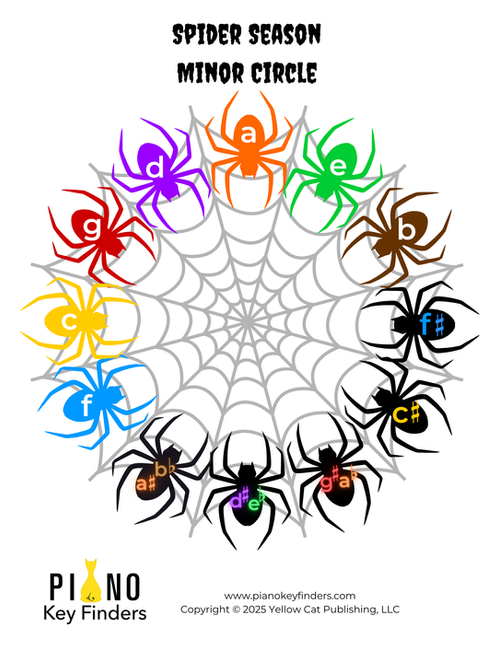Spider Season
- Sarah Lyngra

- Sep 1
- 2 min read
Updated: Sep 8
JUST ADDED BONUS TO SPIDER SEASON
If you want to make spider season a little more spooky, learn the endings in all keys and tag it at the end of The Hairy Scary Spider. This is a first step in quoting from another piece.
September is when giant hairy spiders make their appearance in my little corner of Whidbey Island, Washington State. With bodies the size of fuzzy nickels and 2 inch legs, finding them in the shower is alarming. They weave large webs across outside doorways and openings, trapping unsuspecting students as they arrive for their lessons.
Inspired by nature, the theme of the September Circle is Spiders. And, it's minor.
Of course, a minor circle needs a spider song to go with it. So here's the song:
Some teaching tips:
While the right hand (treble clef) is a 5 note minor scale, the first note of the melody is played with the thumb of the left hand.
The left hand uses a i-V7 cadence where the i chord is a root position triad.
Like a lot of the pieces here, this one transposes nicely, with the same fingering for each key.
Picking numbers between 1-12 or rolling a 12 sided die to choose which key to play the piece in helps students gain fluency in all 12 keys.
The piece can be flipped to major by "unflattening" the 3rd. Flipping between major and minor is a good way to reinforce the flat 3rd and its effect on sound.
Dynamic markings were left out, so you can ask your students to be storytellers with the piece. Are they going to play it quietly because they don't want to startle the spider, or are they going to play it loud because the spider freaks them out?
If you want to add harmonic interest, add the iv chord. Have students experiment with where it sounds the spookiest.
If the chords are too hard for the student at this time, I have them play the first note of the phrase with the left hand, but ignore the chords.
The cards I use when teaching this are the minor i-iv-V7 card from the double sided set for the left hand, and the minor 5 note scale for the right hand.
What am I noticing when I use these with students?
Students are becoming more fluent with playing everywhere on the piano keyboard, not just around the middle, and not just in the most common keys.
Students are more naturally forming shapes to accommodate chords
Students are playing more expressively
The pieces use the correct key signatures. The discussion before playing each key is about how many sharps and flats are in the key, and what are they playing.
In a couple of instances, there are double sharps. They are learning those as well.
These pieces can work with students as young as 5 or 6, but even my adult students are getting something out of them.
The majority of lesson time is spent playing.
For the next several months (September, October, November) more fall themed, and minor pieces in all 12 keys will be coming.
Happy Playing!
Sarah







Comments